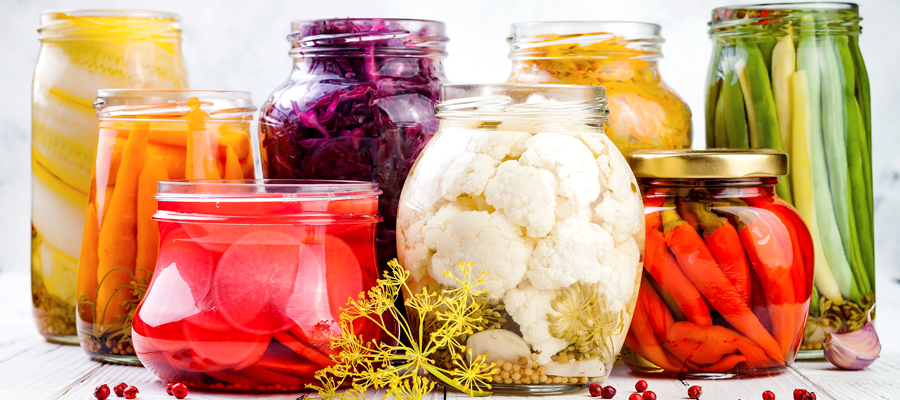A balanced ecosystem of gut bacteria is an integral element for supporting the immune system and maintaining overall health. The human gut consists of a delicate equilibrium of trillions of microbes. This community of bacteria can be thrown into an imbalance by many factors, such as antibiotics, illness, or a poor diet.1
Improve your Gut Health with this Easy Kefir Recipe
One way to maintain a healthy gut microbiome is to incorporate certain probiotics into your diet. Probiotics have the ability to modify your immunological response and fight harmful microbes and microorganisms, helping to ward off many chronic diseases.2
In her blog article, A Healthy Winter Comes from Within, ACHS MS in Holistic Nutrition graduate and Founder of Full Bloom Acres Wellness Lindsay Little shares, "It is said that the immune system lives in the gut. Balancing out the good bacteria and “bad” bacteria is critical to a well-functioning immune system."
One food that contributes to a healthy gut is Kefir. The yogurt-like beverage is rich in probiotics and is made by fermenting kefir grains in milk or a non-dairy alternative. The Kitchn, a popular food and cooking website, offers up a delicious recipe for homemade dairy kefir to support healthy digestion.
Delicious Kefir Recipe
Ingredients
- 1-2 tablespoons of Kefir grains
Acquire kefir grains from a reliable source. Kefir grains are small, gelatinous structures containing a symbiotic mixture of bacteria and yeast and can be purchased from health food stores and Amazon.
- 2 cups of milk (whole or 2%, preferably organic and non-homogenized)
Equipment
- Glass Mason jar (32 oz.)
- Plastic or wooden stirring utensil (avoid metal)
- Breathable cover (cheesecloth, paper towel, or a coffee filter)
- Rubber band or string
- Fine-mesh plastic or nylon strainer
- A bowl
Instructions
- Sterilize a glass jar and plastic or wooden stirring utensil: This ensures a clean environment for fermentation.
- Add Kefir Grains and Milk: Place the kefir grains into the glass jar. Pour the milk over the kefir grains, leaving some space at the top for expansion during fermentation.
- Mix and Cover: Gently stir the milk and kefir grains with a plastic or wooden utensil. Cover the jar with a breathable material such as cheesecloth, a paper towel, or a coffee filter. Secure the cover with a rubber band or string.
- Fermentation: Allow the mixture to ferment at room temperature, away from direct sunlight, for about 12 to 48 hours. The fermentation time can vary based on factors like room temperature and personal taste preferences. The longer it ferments, the tangier and thicker the kefir will become.
- Strain Kefir Grains: After the fermentation period, strain the kefir through a fine-mesh plastic or nylon strainer into a bowl, separating the kefir grains from the liquid.
- Collect Kefir: Collect the strained kefir liquid in a clean container. You can use a funnel to transfer it to bottles for storage.
- Second Fermentation (Optional): If you desire a fizzier kefir, you can conduct a second fermentation in a sealed bottle for an additional 24 hours before refrigerating.
- Refrigerate: Refrigerate the kefir to slow down the fermentation process. It is now ready to be consumed.
- Reuse Grains: Rinse the kefir grains with filtered water before starting a new batch. They can be reused multiple times.
Note that kefir's flavor, consistency, and carbonation can be adjusted by experimenting with factors such as fermentation time, type of milk used, and any additional flavorings or sweeteners added during the second fermentation.
The recipes provided on this platform are intended for informational purposes only and are not a substitute for professional dietary advice, diagnosis, or treatment. Before making any changes to your diet or nutrition plan, consult with a qualified healthcare professional, nutritionist, or dietitian. The creators of these recipes assume no responsibility or liability for any errors or omissions in the content.The recipes may contain common allergens or ingredients that can cause adverse reactions in some individuals. It is the responsibility of the user to be aware of their own dietary restrictions and to seek medical advice if needed. Users are responsible for ensuring the proper handling, cooking, and storage of ingredients to prevent food-borne illnesses. Follow recommended guidelines for food safety and hygiene.
Sources:
1 National Library of Medicine. (2015, April 16). Impacts of Gut Bacteria on Human Health and Diseases. NCBI. https://www.ncbi.nlm.nih.gov/pmc/articles/PMC4425030/
2 Bodke, H. (2022, November 9). Role of Probiotics in Human Health - PMC. NCBI. https://www.ncbi.nlm.nih.gov/pmc/articles/PMC9733784/





